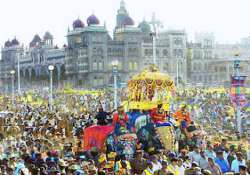Royal procession marks grand finale of Dussehra in Mysore
Mysore (Karnataka), Oct 24: The annual royal procession of 14 caparisoned elephants followed by scores of camels, horses, foot soldiers and cultural troupes through the main streets of this heritage city Wednesday marked the grand

Mysore (Karnataka), Oct 24: The annual royal procession of 14 caparisoned elephants followed by scores of camels, horses, foot soldiers and cultural troupes through the main streets of this heritage city Wednesday marked the grand finale of the 10-day famous Dasara (Dussehra) festival celebrations.
Thousands of people from across the state and country thronged the cultural capital of Karnataka, 140 km from Bangalore, to witness the colourful procession called 'jamboo savari', led by the 52-year-old decked-up tusker Arjuna, carrying a replica of goddess Chamundeshwari atop a 720kg golden throne to the beat of drums and folk music.
The 5,520kg Arjuna replaced its elder and ageing pachyderm Balarama, which carried the throne for the past 12 years
Before the three-mile-long procession began late afternoon from the Ambivalas palace of the Wodiyar dynasty, state Chief Minister Jagadish Shettar worshipped the presiding deity along with scion Srikantadatta Narasimharaja Wadiyar and the royal family members during the auspicious time (dhanur lagna) between 1.46 p.m. and 2.14 p.m.
Since Dasara (Dussehra) is celebrated as a state festival (nada habba) to mark victory of good over evil on the 10th day (Vijayadashmi) of this Hindu calendar month (Kartik masa), Shettar performed the rituals and offered prayers (puja) to 'nandi dhwaja' (royal flagstaff of gods) amid chants of Vedic hymns and sacred mantras by the royal family priests.
Amid tight security across the decorated route, flanked by hundreds of people from all walks of life, the grand procession wound its way to the Bannimantap grounds across the city in four hours for a spectacular torchlight parade where Governor H.R. Bhardwaj received the guard of honour in the presence of dignitaries, including the royal family, Chief Minister Shettar, his cabinet colleagues and their families.
Besides cultural troupes and folk dancers, the mile-long procession had 37 tableaux, including 30 from each district of the state and seven from various government departments, showcasing the rich heritage of the state and its achievements in diverse sectors, including agriculture and horticulture.
The torchlight parade with a dash of cultural extravaganza and acrobatics was followed by an exciting laser show that lit up the cloudy sky and held the thousands of spectators spellbound.
About 4,500 police personnel were deployed across the city to ensure peace and maintain law and order during the day-long fest.
Though the state government scaled down the Dasara events due to severe drought and the month-long agitation over release of Cauvery river water to Tamil Nadu despite deficit monsoon, the spirit of festival gripped the city during the navaratri (nine nights) celebrations since Oct 15.
The Mysore Dasara became a world famous event as the fest is being celebrated over the past 700 years by the Wodiyar dynasty.
Thousands of people from across the state and country thronged the cultural capital of Karnataka, 140 km from Bangalore, to witness the colourful procession called 'jamboo savari', led by the 52-year-old decked-up tusker Arjuna, carrying a replica of goddess Chamundeshwari atop a 720kg golden throne to the beat of drums and folk music.
The 5,520kg Arjuna replaced its elder and ageing pachyderm Balarama, which carried the throne for the past 12 years
Before the three-mile-long procession began late afternoon from the Ambivalas palace of the Wodiyar dynasty, state Chief Minister Jagadish Shettar worshipped the presiding deity along with scion Srikantadatta Narasimharaja Wadiyar and the royal family members during the auspicious time (dhanur lagna) between 1.46 p.m. and 2.14 p.m.
Since Dasara (Dussehra) is celebrated as a state festival (nada habba) to mark victory of good over evil on the 10th day (Vijayadashmi) of this Hindu calendar month (Kartik masa), Shettar performed the rituals and offered prayers (puja) to 'nandi dhwaja' (royal flagstaff of gods) amid chants of Vedic hymns and sacred mantras by the royal family priests.
Amid tight security across the decorated route, flanked by hundreds of people from all walks of life, the grand procession wound its way to the Bannimantap grounds across the city in four hours for a spectacular torchlight parade where Governor H.R. Bhardwaj received the guard of honour in the presence of dignitaries, including the royal family, Chief Minister Shettar, his cabinet colleagues and their families.
Besides cultural troupes and folk dancers, the mile-long procession had 37 tableaux, including 30 from each district of the state and seven from various government departments, showcasing the rich heritage of the state and its achievements in diverse sectors, including agriculture and horticulture.
The torchlight parade with a dash of cultural extravaganza and acrobatics was followed by an exciting laser show that lit up the cloudy sky and held the thousands of spectators spellbound.
About 4,500 police personnel were deployed across the city to ensure peace and maintain law and order during the day-long fest.
Though the state government scaled down the Dasara events due to severe drought and the month-long agitation over release of Cauvery river water to Tamil Nadu despite deficit monsoon, the spirit of festival gripped the city during the navaratri (nine nights) celebrations since Oct 15.
The Mysore Dasara became a world famous event as the fest is being celebrated over the past 700 years by the Wodiyar dynasty.